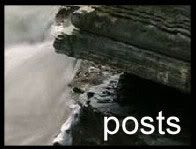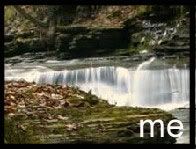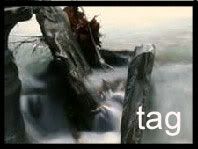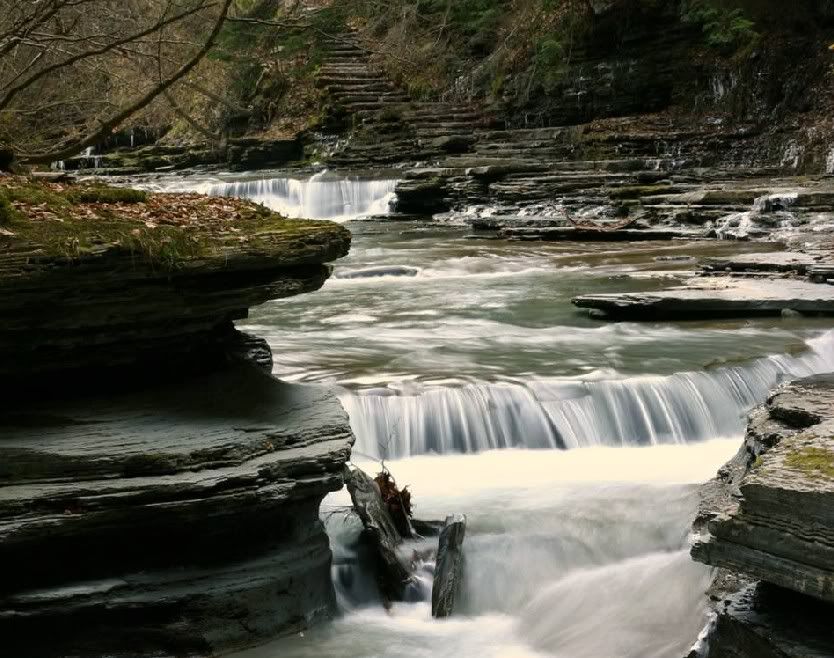

Corals will die if we do not stop the pollution. --- Try your best to save them!
From: http://www.global-warming-awareness2007.org/ From: http://www.sflorg.com/ From: http://www.sciencedaily.com/ Corals will die if we do not stop the pollution. --- Try your best to save them!
Corals will die if we do not stop the pollution. --- Try your best to save them!
Thank you for your time. Hope you are looking forward to out next post! Corals will die if we do not stop the pollution. --- Try your best to save them!
Corals will die if we do not stop the pollution. --- Try your best to save them!
Corals will die if we do not stop the pollution. --- Try your best to save them!
The Video Will Tell You What It Is About!!!!!! SO WATCH! Coral reefs are among the oldest ecosystems on Earth. They are also the largest living structure on the planet. Although coral reefs cover less than 1% of the Earth's surface, they are home to 25% of all marine fish species. 500 million people rely on coral reefs for their food and livelihoods.Coral reefs form natural barriers that protect nearby shorelines from the eroding forces of the sea, thereby protecting coastal dwellings, agricultural land and beaches. Without the existence of coral reefs, parts of Florida would be under water.Coral reefs have been used in the treatment of cancer, HIV, cardiovascular diseases and ulcers. Corals' porous limestone skeletons have been used for human bone grafts.It is estimated that coral reefs provide $375 billion per year around the world in goods and services. If the present rate of destruction continues, 70% of the world's coral reefs will be destroyed by the year 2050. Save our coral reefs! http://www.coralreefalliance.org/ This video is from youtube at this address http://www.youtube.com/watch?v=jR7NsxmxbWM I wish to say thank you to the uploader. Corals will die if we do not stop the pollution. --- Try your best to save them!
Corals will die if we do not stop the pollution. --- Try your best to save them!
Corals will die if we do not stop the pollution. --- Try your best to save them!
Corals will die if we do not stop the pollution. --- Try your best to save them!
Corals will die if we do not stop the pollution. --- Try your best to save them!
Corals will die if we do not stop the pollution. --- Try your best to save them!
Corals will die if we do not stop the pollution. --- Try your best to save them!
Corals will die if we do not stop the pollution. --- Try your best to save them!
Corals will die if we do not stop the pollution. --- Try your best to save them!
Let me share with you!
Coral reefs are aragonite structures produced by living organisms, found in marine waters with little to no nutrients in the water. High nutrient levels such as those found in runoff from agricultural areas can harm the reef by encouraging the growth of algae. In most reefs, the predominant organisms are stony corals, colonial cnidarians that secrete an exoskeleton of calcium carbonate. The accumulation of skeletal material, broken and piled up by wave action and bioeroders, produces a massive calcareous formation that supports the living corals and a great variety of other animal and plant life. Although corals are found both in temperate and tropical waters, shallow-water reefs are formed only in a zone extending at most from 30°N to 30°S of the equator. Tropical corals do not grow at depths of over 50 m (165 ft). Temperature has less of an effect on the distribution of tropical coral, but it is generally accepted that they do not exist in waters below 18 °C.However, deep water corals can exist at greater depths and colder temperatures. Although deep water corals also form reefs, very little is known about them.
Coral Reefs in the past..
Throughout the Earth history, from a few million years after hard skeletons were developed by marine organisms, there were almost always reefs formed by reef-building organisms in the ancient seas. The times of maximum development were in the Middle Cambrian (513-501 Ma), Devonian (416-359 Ma) and Carboniferous (359-299 Ma), due to Order Rugosa extinct corals, and Late Cretaceous (100-65 Ma) and all Neogene (23 Ma - present), due to Order Scleractinia corals.
Not all reefs in the past were formed by corals: in the Early Cambrian (542-513 Ma) resulted from calcareous algae and archaeocyathids (small animals with conical shape, probably related to sponges) and in the Late Cretaceous (100 -65 Ma), when there also existed reefs formed by a group of bivalves called rudists; one of the valves formed the main conical structure and the other, much smaller valve acted as a cap.
Infomation from Wikipedia
at 10:42 AM



From: http://www.coralsea.net/
at 10:34 AM
Just a short observation and inner speculation...
Standing on the edge, twisted branch breaks way colors, explode beneath gray water a man walks to me and says; "We cannot build here, they say that Mangroves are in our way." what a shame, he's shaking his dark head A cell in me jumps up to agree, for what a joy to erect a cabin, some structure upon this paradise by the sea... I gaze at the coral reef hidden under sunlit waves 'a single touch-a piece dies,' the divers caution yet I recall reaching for it like gold, a Midas touch will destroy even a tiny pink branch of its brittle beauty "Am I a victim of my own grasping?" I ask this stranger, so angry that his own reaching hand has been slapped by the rules, "Like Butterfly wings, I touch without thinking," I tell him. I touch without thinking-and the insect crumbles never belonging to me, yet I continue to swipe these delicate gifts, fancied only as possession's, rather than settling for a satisfied gaze, I'll never tame beauty with touch nor taste How could it be that the whole world does not belong to me? "We don't want the world," the stranger argues, "Only this small piece, a tiny parcel. Is it too much to ask for? A new home by the sea?" "The Mangroves should stay," I say. the man's face churns red, "Oh, one of those," he huffs, his arms unfolding in a circle, as if to hug a tree I watch, realizing I'm one of him, but only in soiled spirit when I used to want everything my own way, though I try to understand this sudden cleansing of my soul I need to walk backward a while, hovering too long on two legs, is a stature certain to be self-absorbing The winds have turned me inside-out I still like improvement-but more naturally Must we fight nature with such aggressive fists, a fighting pose that will certainly turn back on us in the shape of a sword? You know better than I what the sea needs, I whisper alone in the dark The knotted limbs of the old Mangroves are no longer mere shadows to me, they bow politely to sundown, like sleepy shepherds, gently guarding all this ocean against so many two-legged wolves. Copyright by Chrissy K. McVay
Taken from: http://www.authorsden.com/visit/viewpoetry.asp?AuthorID=30288&id=150416
at 10:30 AM
at 4:43 PM
 Did you known that coral reefs are like underwater cities. The millions of nooks and crevices(a narrow opening resulting from a split or crack) along sprawling reefs offer the marine animals of all shapes and sizes places to hide, sleep, feed, and breed. In fact at least a fourth of all known marine species live in reefs.
Did you known that coral reefs are like underwater cities. The millions of nooks and crevices(a narrow opening resulting from a split or crack) along sprawling reefs offer the marine animals of all shapes and sizes places to hide, sleep, feed, and breed. In fact at least a fourth of all known marine species live in reefs.  As in any city the citizens of a reef operate on different schedules.Some are early risers, others are night owls. During the day the city explodes with color. The bright hues and patterns of tropical fish may serve to camouflage them as they feed in sunlit waters. Night feeders tend to be duller, the better to lurk in dark alleys for prey.
As in any city the citizens of a reef operate on different schedules.Some are early risers, others are night owls. During the day the city explodes with color. The bright hues and patterns of tropical fish may serve to camouflage them as they feed in sunlit waters. Night feeders tend to be duller, the better to lurk in dark alleys for prey.
at 4:19 PM
 The reef -- that stretches nearly 700 miles from the northern tip of Mexico’s Yucatan Peninsula to the Bay Islands in northern Honduras -- is part of a larger interconnected system of currents and habitats that stretch throughout the Caribbean Basin and beyond and is one of the region's greatest natural assets. Its massive structure provides an important defense against storms and coastal erosion, while the living reef and associated ecosystems support recreation and commercial fishing.
The reef -- that stretches nearly 700 miles from the northern tip of Mexico’s Yucatan Peninsula to the Bay Islands in northern Honduras -- is part of a larger interconnected system of currents and habitats that stretch throughout the Caribbean Basin and beyond and is one of the region's greatest natural assets. Its massive structure provides an important defense against storms and coastal erosion, while the living reef and associated ecosystems support recreation and commercial fishing.
WWF has placed a high priority on protecting the Mesoamerican Reef. For the past two decades, World Wildlife Fund has been on the ground and in the waters of the Mesoamerican Reef ecoregion to ensure this Caribbean treasure is preserved for future generations. The place. A large mosaic of ecosystems, the Mesoamerican Reef covers nearly 115 million acres—from the northern end of the Yucatán Peninsula in Mexico and the Caribbean coasts of Belize and Guatemala, to the Bay Islands in northern Honduras. It includes ocean habitats, coastal zones, tropical and cloud forests, and watersheds that drain the Caribbean slope.
The place. A large mosaic of ecosystems, the Mesoamerican Reef covers nearly 115 million acres—from the northern end of the Yucatán Peninsula in Mexico and the Caribbean coasts of Belize and Guatemala, to the Bay Islands in northern Honduras. It includes ocean habitats, coastal zones, tropical and cloud forests, and watersheds that drain the Caribbean slope. The species . The Mesoamerican Reef hosts more than 65 species of stony coral and more than 500 species of fish—including commercially-vital grouper, snapper and spiny lobster. It also provides refuge for sea turtles that feed and nest along the shoreline. Its watershed is home to jaguars, howler monkeys and birds such as the quetzal.
The species . The Mesoamerican Reef hosts more than 65 species of stony coral and more than 500 species of fish—including commercially-vital grouper, snapper and spiny lobster. It also provides refuge for sea turtles that feed and nest along the shoreline. Its watershed is home to jaguars, howler monkeys and birds such as the quetzal. The people. More than two million people live in the coastal communities that span four countries. This population of great cultural and ethnic diversity depends on economic activities linked to coastal and marine resources, such as fishing and tourism. The region is also experiencing rapid population growth and increased exploitation of land and resources.
The people. More than two million people live in the coastal communities that span four countries. This population of great cultural and ethnic diversity depends on economic activities linked to coastal and marine resources, such as fishing and tourism. The region is also experiencing rapid population growth and increased exploitation of land and resources.
at 5:32 PM
at 4:28 PM
Coral reefs are the foundation, the support of marine life, and thus a extremely crucial support for human life, yet all over the world humans are destroying them, killing them at a disastrous rate. Already 10 percent of the total population of coral reefs are lost and scientists are predicting that 70 percent more of the population will be lost in 20 to 40 years time unless people doing what their doing. Examples are Pollution, Sewage, Erosion, Cyanide Fishing, Clumsy Tourism,Etc. But there is still hope as reefs are resilient and they bounce back quickly when protected.
It's protection that is vital, and it's ordinary people who are making it happen. Government efforts in much of the world with all due respect have been frankly pathetic, late, weak, underfunded and unenforced. Persian Gulf oil states pass toothless pollution laws then ignore them. Indian Ocean poachers outwit and outnumber British Royal Navy patrols. Ecuador stalls for decades while tourism explodes in the delicate Galapagos, only to relentless destruction of coral reefs. In those bright where people are changing the way they treat the reefs, you'll find fishermen, students, divers, biologists, concerned citizens of all stripes transformed into activists and volunteers, taking matters into their own hands to protect the coral reefs that are dear to them and vital to us all on earth.
It was Key West dive operators who launched Reef Relief to keep ship anchors off Florida's dying reefs. It was a lone Pacific Islands environmental consultant who crusaded to restore the giant clam to Tonga's depleted reefs. And it was a passel of marine scientists, alarmed by their findings as frustrated with the government inaction, who launched last year's International Year Of The Reef, a global research and education program to spur coral conservation efforts and reverse the trend of destruction. Their call to action has made a difference: Conservationists and governments worldwide made launched the International Coral Reef Initiative in 1997, and the United Nations followed their lead and declared 1998 the International Coral Of The Reef Ocean.
I hope this piece of information from MotherJones.com rephrased by me would encourage or inspire you to help in the restoration of our once beautiful pollution-free world.
at 2:55 PM
Deep Water Corals
Many people are familiar with the coral reefs that thrive in shallow, well lighted, clear tropical waters where myriad colorful hard and soft corals provide habitat "infrastructure" for numerous invertebrates and fishes. The corals provide protection and
Three main groups of corals make up deep-water coral communities: hard (stony) corals of the Order Scleractinia, which form hard, ahermatypic reefs; black and horny corals of the Order Antipatharia; and soft corals of the order Alcyonacea, which includes the gorgonians (sea fans) (Williams, 2001). Deep-water corals are similar in some ways to the more familiar corals of shallow, tropical seas. Like their tropical equivalents, the hard corals develop sizeable reef structures that host rich and varied invertebrate and fish fauna. However, unlike their tropical cousins, which are typically found in waters above 70m depth and at temperatures between 23° and 29° C, deep-water corals live at depths just beneath the surface to the abyss (2000 m), where water temperatures may be as cold as 4° C and utter darkness prevails.  At these depths, corals lack zooxanthellae. These symbiotic algae provide food for many shallow-water corals through photosynthesis. They also assist in the formation of the calcareous skeleton, and give most tropical corals their coloration. By contrast, the polyps of deep-water corals appear to be suspension feeders. They capture and consume organic detritus and plankton that are transported by strong, deep-sea currents. These corals are commonly found along bathymetric highs such as seamounts, ridges, pinnacles and mounds (Southampton Oceanography Centre).
At these depths, corals lack zooxanthellae. These symbiotic algae provide food for many shallow-water corals through photosynthesis. They also assist in the formation of the calcareous skeleton, and give most tropical corals their coloration. By contrast, the polyps of deep-water corals appear to be suspension feeders. They capture and consume organic detritus and plankton that are transported by strong, deep-sea currents. These corals are commonly found along bathymetric highs such as seamounts, ridges, pinnacles and mounds (Southampton Oceanography Centre).
Deep-water corals range in size from small solitary colonies to large, branching tree-like structures, which appear as oases of teeming life surrounded by more barren bathymetry. The gorgonians (sea fans) also range from small individuals to those with tree-like dimensions. The gorgonian, Paragorgia arborea, may grow in excess of three meters in length (Watling, 2001). Growth rates of branching deep-water coral species, such as Lophelia and Oculina, range from ~ 1.0 - 2.5 cm/yr, whereas branching shallow-water corals, such as Acropora, may exceed 10-20 cm/yr. Using coral age-dating methods, scientists have estimated that some living deep-water corals date back at least 10,000 years (Mayer, 2001). However, little is known of their basic biology, including how they feed or their methods and timing of reproduction.
General Distribution of Cold-water Corals
Deep-water corals are found globally, from coastal Antarctica to the Arctic Circle. In northern Atlantic waters, the principal coral species that contribute to reef formation are Lophelia pertusa, Oculina varicosa, Madrepora oculata, Desmophyllum cristagalli, Enallopsammia rostrata, Solenosmilia variabilis, and Goniocorella dumosa. Four of those genera (Lophelia, Desmophyllum, Solenosmilia, and Goniocorella) constitute the majority of known deep-water coral banks at depths of 400 to 700 m (Cairns and Stanley, 1982).Madrepora oculata occurs as deep as 2,020 m and is one of a dozen species that occur globally and in all oceans, including the Subantarctic (Cairns, 1982). Colonies of Enallopsammia contribute to the framework of deep-water coral banks found at depths of 600 to 800 m in the Straits of Florida (Cairns and Stanley, 1982).
Two Important Deep-water Corals
Two of the more significant deep-sea coral species are Lophelia pertusa and Oculina varicosa. These species form extensive deep-water communities that attract commercially important species of fishes, making them susceptible to destructive bottom trawling practices (Reed, 2002a). Increased sedimentation places additional stress on corals.Oil and gas exploration structures and activities, particularly in the North Sea and adjacent areas, also damage Lophelia communities. Subsequent oil and gas production activities may also introduce noxious substances into these areas.
at 4:26 PM
The upper reef varies in depth from 20' near the cliffline, to 55-60 ft at the upper opening of the shaft. From there it drops downward to 300+ feet. The first opportunity to exit the shaft is at 127 feet. It is common to see large pelagic fish below and as you follow the wall on the outside of the Blue Hole you probably will see more.
Gliding down the awe-inspiring shaft can get even the most experienced diver’s adrenaline up, so watch your descent rate and depth carefully. Soft and hard corals, sea whips, fish and eels can be seen inside the shaft.
Once out of the shaft, ascend to about 80 feet and follow the contour of the wall for a while. Then ascend to the 60’ reef flat where there is a variety of hand-fed fish and several rock mounds covered with interesting corals and algae. Watch for large trigger fish and lots of schooling fish.


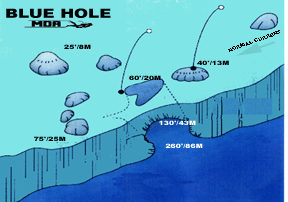
at 4:01 PM
Here are some fast facts taken from the panda organisation (http://www.panda.org/)
Counting only the economic value of fisheries, tourism, and shoreline protection, the costs of destroying 1km of coral reef ranges between US$137,000-1,200,000 over a 25-year period (World Resources Institute (WRI))
Properly managed coral reefs can yield an average of 15 tonnes of fish and other seafood per square kilometre each year (WRI)
Southeast Asia's coral reef fisheries alone are estimated to yield US$ 2.4 billion annually (WRI press release)
More than 80% of the world's shallow reefs are severely over-fished (Australian Government Report (PDF file))
32 of the 34 recognised animal Phyla are found on coral reefs compared to 9 Phyla in tropical rainforests (Status of Coral Reefs of the World, GCRMN)
Occupying less than one quarter of 1% of the marine environment, coral reefs are home to more than 25% of all known marine fish species (WRI Reefs at Risk)
58% of the world's coral reefs are potentially threatened by human activity (WRI Reefs at Risk)
Coral reefs are found in 109 countries; significant reef degradation has occurred in 93 (Seaweb)
From 1876-1979 only three bleaching events were recorded, whereas 60 are on record from 1980 until 1993 (Glynn, P.W. 1993. Coral reef bleaching: ecological perspectives. Coral Reefs 12:1-17); in 2002 more than 400 events were recorded (Reef education (Australia), UNEP)
We have already lost 27% of the world's coral reefs. If present rates of destruction are allowed to continue, 60% of the world's coral reefs will be destroyed over the next 30 years (Cesar, Degradation report, PDF file)
More than 450 million people live within 60 kilometres of coral reefs, with the majority directly or indirectly deriving food and income from them (Seaweb)
The total economic value of Indonesia 's reefs is estimated at US$1.6 billion annually (WRI press release)
The total economic value of Philippine reefs is estimated at US$1.1 billion annually (WRI press release)
Coral reefs in the Malacca Straits have an economic value of US$563 million (WRI press Release)
Southeast Asia is considered the global epicentre of marine diversity. Its 100,000km2 of coral reefs (34% of the world's total) are home to over 600 of the 800 reef-building coral species in the world (WRI press release)
Indonesia and the Philippines hold 77% of Southeat Asia's coral reefs and nearly 80% of threatened reefs (WRI press release)
Thank you for your attention and please comment!
at 5:53 PM
Question: Can you tell me the importance of coral reefs?
Wynne A Wells
Answer:
Coral reefs are important for many different reasons:
*the coral reef is "biologically diverse" that means there
are many different kinds of animals and plants that live theree
This is important, because just like the tropical rainforests,
Coral reefs may be the source of medicines, chemicals or other
resources that haven't even been discovered yet, and unless we
save these environments, we'll never get the chance to discover
these resources that we need;
*Coral reefs are "biologically productive" , which means there are
lots of each thing that grows here. Many of the creatures that l
live here, like lobsters and fish, we depend on for food, even
here in the Midwest , and all around the world!
*Coral reefs are beautiful places, and provide income from
tourists to many otherwise poor countries around the world.
*Reefs are very stable, and provide a protective barrier around
many islands and coasts. Without the reefs these islands and
coasts will erode away into the ocean.
*It is important to protect the reefs we have today, because they
can't be replaced. Reefs are formed very slowly by tiny animals
called "coral". Each animal is tinier than your pinky nail, and
grows very slowly, only about 1 centimeter a year. The reefs we have
today were formed over 100s of thousands of years, and
it would take just as long to grow back, if they grow back at all
Oil drilling and erosion from developing coasts near reefs are big problems.
Tom F Ihde
Interesting isint it?
at 5:51 PM
 Reef history
Reef history
Today this term refers only to organic structures, originated from accumulation of reef-builders’ skeletons (today the main reef builders are corals – that’s why the most common reefs are coral reefs). Reefs have dense structure resistable to wave action. The highest biodiversity and the fastest growth of reefs are in coastal water zone on depth not bigger than 10 m. (for comparison: only by large ships, as big as, for example Titanic, draught could be as big as about 10m.)
Many organisms have been built reef-like structures since the begin of Paleozoic era (about 570 millions ago). There were Archaecyatha (they had been living only during the Cambrian period) and Algae. For comparison Homo sapiens has exist on Earth for 200 thousand years; Earth has 4,6 billion years.
During Carboniferous, Devonian, Silurian and Ordovician it were the following builders of reef-like structures:- Rugosa and Tabulata, Hydrozoa and Bryzoa. During Permian and Carboniferous these were: Rugosa, Tabulata, Algae, Spongiae and Bryzoa. Since Mesozoic the main reef-builders were Scleractinia and Rhodophyta (red seaweeds), Bryzoa and Hydrozoa.
at 5:16 AM

Coral reefs grow through a process of increasing their calcareous skeleton mass and their overlying living tissue. The term "calcification" refers to the fact the process in which calcium builds up to form a solid mass. The coral skeleton is composed of aragonite, which is calcium carbonate (CaCO3) in a fibrous, crystalline form, where it must be noted that calcite, the common form of CaCO3, is not present anywhere in the skeleton. Algae also deposit aragonite or a soluble calcite form with a high magnesium content in the terms of the reefs. Heinz A. Lowenstam of California Institute of Technology showed in Bermuda that some calcareous organisms deposit less soluble calcite during colder seasons and more soluble aragonite during warmer seasons. The mechanism that controls the seasonal CaCO3 deposition variation is so far unknown.
Zooxanthellae are required in the process of building up the reef’s skeleton. Zooxanthellae speed up the calcium carbonate precipitation. This causes new layers of skeleton to be formed. There are cations of calcium Ca2+ and anions of bicarbonate HCO3- in the coral mucus. The two ions react and produce Ca(HCO3)2.:
Ca2+ + 2HCO3- Ca(HCO3)2
from which calcium carbonate and carbon acid originate:
Ca(HCO3)2 CaCO3 + H2CO3
Calcium carbonate crystallize on existing aragonite crystals. In this way of a new skeletal layer forms.
Carbonic acid resolves itself into carbon dioxide and water:
H2CO3 CO2 + H20
Coral polyps absorb calcium ions from seawater and are transferred by both diffusion and an active pump mechanism that ends at the area being calcified. This is important because calcium is used in cell metabolism for regulation. The calcium concentrations must be low or else it will interfere with coral tissue functions. The concentration of free calcium ions is lower in corals than in seawater because the calcium ions stick to membranes or organic molecules. Lothar Böhm at the University of the West Indies in Jamaica showed through his studies that calcium has a high turnover rate.
The process in which the skeleton is made takes place during the day with great intensity. At night skeleton growth abates and slows down. The growth depends also on the season of the year, age and shape of corals. Young corals grow much faster than old corals, sphere corals grow slower than corals which have branched shape. A fact of particular interest is that corals are able to change their shape during their life to aid in sunlight retrieval. Temperature is also very important, for corals grow best in temperatures between 25-27oC.
Factors Influencing Calcification
Fish and invertebrates live and hide in the coral cracks, while sessile animals live on undersides of corals. A reef’s crest runs parallel to the coast, sometimes as close as up to the shore. The reef can also makes lagoons 5 meters deep, sandy, and a few hundred meters wide. The reefs are isolated from waves and speckled with coral heads. The lagoon contains many patches of calcareous algae and bottom-living animals like sea urchins, and sea cucumbers. The bottom-living animals actually filter organic matter out of the sediment. There are dense lawns of the sea grass Thalassia that are habitats of sea urchins, conchs and others.
On the seaside of the corals are the fore reef where corals blanket the sea floor. The corals form buttresses divided by narrow, sandy channels through which flow fine sediment flows. The channels can be 10 meters deep and are roofed with corals. These channel pathways are necessary because the coral reef would suffocate otherwise. Down away from the buttress zone is a coral terrace. From there, there is a slope of sand with coral pinnacles, then another terrace, and finally a vertical wall dropping off.
In nature, coral species are distributed by depth. Very few algae or symbiotic corals grow well past 100 meters because of the lack of light. As a matter of fact, the animals that live past 100 meteres mostly feed off of the detritus from above. Detritus feeders include true sponges, antipatharians (“precious corals”) and gorgonians (sea fans). Also, there are sclerosponges. Sclerosponges are an ancient group of major reef builders which were once believed extinct, but have been found in Jamaica living at a lower water level. The reason for the lower water level appears to be because faster-growing corals displaced the Sclerosponges, forfeiting in Darwin’s “survival of the fittest.” (Darwin’s theory of evolution stated that species suited for their environment will continue to thrive and may even displace species less suited for their environment, hence the name, survival of the fittest.)
Dependencies between the Coral Body and the Skeleton
The coral body is made up of a basal and oral discs and walls that create the polyp’s shape. The basal disc forms the bottom of the tubular skeleton, and the walls form the sides. Each place where a coral polyp lives is called a calice. The calice is the distal part of the coral skeleton. One might also hear the term coralite to describe the same term. They are the same, exact thing.
A calice is divided into different chambers by vertical plates called septa. Septa are a part of the skeleton and built from calcium carbonate. Coral septa form radially. This means that the septal plates start at the wall and grow toward the center. Young corals start out with only six septa. This constitutes the first stage in the septal cycle. As each step progresses, the older septum chamber splits to create two new septum chambers. In this way, the number of chambers doubles. The second stage of the septal cycle doubles the existing number of septa and creates six more septa. The total number of septa in the coral is now twelve. The third step of the cycle produces twelve septa for a total of twenty-four. The fourth stage produces twenty-four septa for a total of forty-eight, and so on.
A mesentery is a fleshy septum built of a soft epithelium. Mesenteries are fixed to an oral disk and appear to stream down like curtains dividing coral coelenteron. Digestive filaments and the gonads are attached to the mesenteries that do not connect to the pharynx. The mesentery has gastroderm and mesoglaea. Mesenteries always occur in pairs. Skeletal septa are as cyclical in arrangement as mesenteries There is usually one septum between two paired mesenteries. The first septal cycle appears before the first cycle of mesenterial pairs do.
at 5:16 AM

Assessing the Threat
Estimated threat to coral reefs: High=Red Medium= Yellow Low= Blue
The Reefs at Risk analysis produced a map-based indicator of potential threats to coral reefs. In order to capture the potential threats to coral reefs from coastal development, marine pollution, overexploitation of marine resources, and inland pollution, distance-based threat surfaces were developed from 12 representative stressors. These included cities, settlements, airports and military bases, population density, mines, tourist resorts, ports, oil tanks and wells, shipping routes, and areas where blast fishing or fishing using poisons is known to occur. Additionally, a watershed-based model was used to estimate potential erosion within the watershed to produce an estimate of areas potentially threatened by inland pollution and sedimentation. The 13 threat surfaces were integrated with data on coral reef locations, resulting in a global classification of potential threat to coral reefs.
Data Sources: Reef locations are based on 4-kilometer-resolution gridded data reflecting shallow coral reefs of the world by the World Conservation Monitoring Centre (WCMC).
Reefs are classified according to the Reefs at Risk Indicator, an estimate of potential threat to coral reefs developed at the World Resources Institute (WRI). This estimate is a composite of four separate risk factors:
Coastal development
Marine-based pollution
Overexploitation and
Inland pollution and erosion
Map projection: Mercator
The Reefs at Risk project is a collaboration of the World Resources Institute, the International Center for Living Aquatic Resources Management, and the World Conservation Monitoring Centre.
For more information, visit the Reefs at Risk website (http://www.wri.org/wri/reefsatrisk/)
Source:WRI
at 2:39 AM
COME AND COMMENT
Find out more about corals and marine life at these websites!
http://www.reefrelief.org
http://www.panda.org
http://www.uvi.edu
http://www.coral.org
http://www.iyor.org
http://www.coris.noaa.gov
http://healthyreefs.org
http://www.coralreef.gov
Credits
chocbanana[trixieandtheresa]

